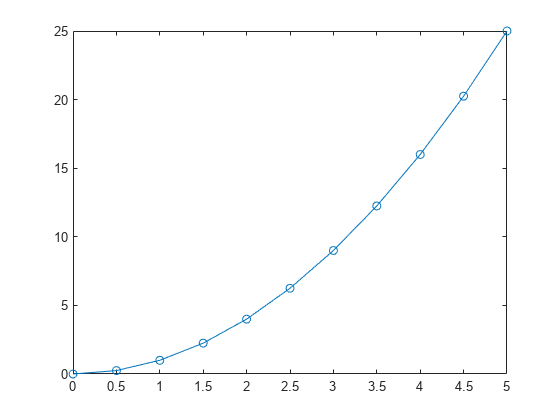ode23
비경직성(Nonstiff) 미분방정식 풀기 — 저차수법(Low order method)
구문
설명
[입니다. 여기서 t,y] = ode23(odefun,tspan,y0)tspan = [t0 tf]는 t0에서 tf까지의 구간에서 초기 조건 y0을 사용하여 연립미분방정식 를 적분합니다. 해 배열 y의 각 행은 열 벡터 t에 반환된 값에 대응합니다.
모든 MATLAB® ODE 솔버는 형식의 연립방정식이나 질량 행렬이 있는 문제 를 풀 수 있습니다. 솔버는 모두 유사한 구문을 사용합니다. ode23s 솔버는 상수 질량 행렬을 갖는 문제만 풀 수 있습니다. ode15s와 ode23t는 특이 질량 행렬을 포함하는 문제(즉, 미분대수 방정식(DAE))를 풀 수 있습니다. odeset의 Mass 옵션을 사용하여 질량 행렬을 지정합니다.
[는 이벤트 함수라고 하는 (t,y)의 함수가 0인 위치를 추가로 찾습니다. 출력값에서 t,y,te,ye,ie] = ode23(odefun,tspan,y0,options)te는 이벤트 발생 시간이고, ye는 이벤트 발생 시 계산된 해이며, ie는 트리거된 이벤트의 인덱스입니다.
각 이벤트 함수에 대해, 0에서 적분을 종료할지 여부와 영점교차의 방향을 고려할지 여부를 지정합니다. 이를 수행하려면 'Events' 속성을 함수(예: myEventFcn 또는 @myEventFcn)로 설정하고 대응 함수 [value,isterminal,direction] = myEventFcn(t,y)를 생성합니다. 자세한 내용은 ODE 이벤트 위치 항목을 참조하십시오.
sol = ode23(___)deval과 함께 사용하여 구간 [t0 tf] 내의 임의의 점에서 해를 계산할 수 있는 구조체를 반환합니다. 위에 열거된 구문에 나와 있는 입력 인수를 원하는 대로 조합하여 사용할 수 있습니다.
예제
입력 인수
출력 인수
알고리즘
ode23은 명시적 룽게-쿠타(Explicit Runge-Kutta) (2,3) 공식인 보가키-샴파인(Bogacki-Shampine) 쌍을 구현한 것입니다. 이 솔버는 허용오차가 엄격하지 않거나 반경직성(Moderately Stiff)이 있는 경우 ode45보다 더 효율적일 수 있습니다. ode23은 단일 스텝(Single-step) 솔버입니다. ([1], [2])
참고 문헌
[1] Bogacki, P. and L. F. Shampine, “A 3(2) pair of Runge-Kutta formulas,” Appl. Math. Letters, Vol. 2, 1989, pp. 321–325.
[2] Shampine, L. F. and M. W. Reichelt, “The MATLAB ODE Suite,” SIAM Journal on Scientific Computing, Vol. 18, 1997, pp. 1–22.
확장 기능
버전 내역
R2006a 이전에 개발됨












